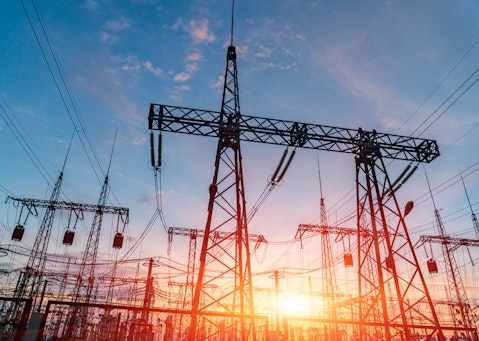In this piece, we will take a look at the 12 best utilities ETFs to buy. If you want to skip our introduction to the utility sector, then take a look at 5 Best Utilities ETFs to Buy.
Courtesy of the global shift to renewable energy and the turmoil in the energy market after the Russian invasion of Ukraine, the utility industry has shaped up to be one of the rather dynamic sectors you’re likely to come across. Utility companies are the backbone of the economy, as they are responsible for providing electricity, water, gas, waste management, and other services to keep modern day cities functional. At the same time, the financial health of utilities and the way their payment structures are quite important, as improper management or structuring can often lead to fiscally unsustainable arrangements that have the potential to collapse entire economies.
The biggest example of this phenomenon comes through the ailing Western Asian nation Lebanon. Lebanon is the perfect case study of the effects of a divergence in the interests of a country’s ruling elite and its citizens. Its financial system is dominated by Hezbollah and banks became insolvent in 2019 as the country was unable to keep the U.S. dollar stable. This depreciation of the Lebanese Pound left its government unable to buy oil to run power plants. which led to nationwide blackouts. The impact of a poor economy continues to be felt in the Lebanese power sector, as the government is capable of providing only a couple of hours of electricity during the day with the remaining power generation left to the consumer. At the heart of the crisis is the utility Électricité du Liban (EDL) which often sees nepotistic management providing lucrative contracts on favoritism and profit from the market for diesel generators as well.
Another country that has failed to manage its utilities is Pakistan. One of the most populous nations in the world, Pakistan’s energy sector is a ticking time bomb. The government is the only entity allowed to purchase electricity in the country, and it often fails to recover these costs from distribution companies leading to circular debt of billions of dollars. The country saw protests in major cities earlier this year after the government increased electricity prices to remove subsidies and recover the circular debt, and officials, who often benefit from state provided free of cost electricity, have been unable to come up with solutions to solve these problems.
Safe to say, the utility sector is far more important to a country’s economic health than is generally believed. Switching gears and focusing on the U.S., the American utilities market was worth $993 billion in 2020 and is slated to grow at a compounded annual growth rate (CAGR) of 1.5% until 2025 to be worth an estimated $1 trillion by the end of the forecast period. The U.S. utility market was also better off last year when compared to Organization for Economic Co-operation and Development (OECD) peers as far as energy inflation was concerned. Energy inflation in the OECD stood at 28.1% last year on average, while inflation in the U.S. was at 17.1%. However, since America generates a large portion of its electricity from natural gas, it also suffered from high electricity prices which shot up to multi year highs as global demand for natural gas soared and led to tight supplies. Some of the biggest U.S. utilities are Duke Energy Corporation (NYSE:DUK), NextEra Energy, Inc. (NYSE:NEE), and The Southern Company (NYSE:SO), and you can check out 16 Biggest Utility Companies in the US for all the details about the U.S. utility sector.
As to what lies ahead for the utility sector, here’s what the management of Duke Energy Corporation (NYSE:DUK) had to say during the firm’s second quarter earnings call:
The long term residential growth trajectory remains strong. In fact, residential volumes have averaged just under 1% growth per year for the past five years, and are 4% above pre pandemic levels. In the commercial class, second quarter volumes are trending above our full year estimate, supported by continued growth in data centers. In the industrial class, planned investment in our territories continues to be robust. Many of our large customers are expanding, and we partnered with our states to attract over 29,000 new jobs and $23 billion in capital investment in 2022.
These investments represent several key sectors such as battery, EVs and semiconductors, and we expect they will provide around 2000 megawatts of demand as operations ramp up. The strength of our service territories was also reflected in CNBCs annual list of America’s top states for business, were five of the states we serve ranked in the top 15 and North Carolina ranked number one for the second year in a row. In the near term, we’ve seen a slight pullback in some of our manufacturing customers due to softening demand in certain sectors of the economy. We’re monitoring the impact of macroeconomic trends but the underlying fundamentals, residential customer growth, and commercial and industrial investment continue to support long term growth at roughly 0.5% per year.
Moving towards exchange traded funds (ETFs), there are among the many ways in which one can invest in the stock market. ETFs provide a collection of stocks to invest in and they are generally traded similarly to shares on the market. Each unit or share of an ETF represents the collective share price performance of its constituents and an ETF can also be considered as an instrument that allows a regular investor to outsource stock selection to others and simply invest in sectors that they believe should do well in the current economic environment.
Today, we’ll focus on ETFs that target the utility industry, and some notable picks in the selection are iShares U.S. Infrastructure ETF (BATS:IFRA), Global X U.S. Infrastructure Development ETF (BATS:PAVE), and Virtus Reaves Utilities ETF (NYSE:UTES). For more ETFs, you can look at 12 Best Healthcare ETFs To Buy and 10 Best Gold ETFs.

High-voltage power lines. Electricity distribution station. high voltage electric transmission tower. Distribution electric substation with power lines and transformers.
Our Methodology
To compile our list of the best utilities ETFs to buy, we first ranked the 23 biggest ETFs through their market capitalization. Then, their share price gains for the past five years was determined and the top 12 utility ETFs are as follows.
12 Best Utilities ETFs to Buy
12. First Trust Utilities AlphaDEX Fund (NYSE:FXU)
5 Year Share Price Gains: 7.81%
First Trust Utilities AlphaDEX Fund (NYSE:FXU) is a medium sized ETF that focuses primarily on value stocks. More than 88% of its investments are in utility companies, and the fund has $306 million in net assets. Top holdings in the First Trust Utilities AlphaDEX Fund (NYSE:FXU) are Vistra Corp. (NYSE:VST) and Consolidated Edison, Inc. (NYSE:ED). Looking at hedge fund sentiment, 48 hedge funds part of Insider Monkey’s database had bought Vistra Corp’s shares in Q2 while 30 had held a stake in Consolidated Edison.
Along with Global X U.S. Infrastructure Development ETF (BATS:PAVE), iShares U.S. Infrastructure ETF (BATS:IFRA), and Virtus Reaves Utilities ETF (NYSE:UTES), First Trust Utilities AlphaDEX Fund (NYSE:FXU) is one of the best utility ETFs to buy based on share price performance.
11. Vanguard Utilities Index Fund (NYSE:VPU)
5 Year Share Price Gains: 11.02%
Vanguard Utilities Index Fund (NYSE:VPU) is one of the larger ETFs on our list, with $7 billion in net assets. Like the First Trust Utilities AlphaDEX ETF, it also invests in value and mid sized stocks. 99% of its holdings are in utility stocks, with the top three holdings being Duke Energy Corporation (NYSE:DUK), NextEra Energy, Inc. (NYSE:NEE), and Suncor Energy Inc. (NYSE:SU). Hedge fund investors in these, out of the 910 part of Insider Monkey’s second quarter of 2023 database stand at 39, 59, and 33, respectively.
10. ClearBridge Sustainable Infrastructure ETF (NASDAQ:INFR)
5 Year Share Price Gains: 11.17%
ClearBridge Sustainable Infrastructure ETF (NASDAQ:INFR) is a small exchange traded fund with $2 million in net assets. It invests in both value and growth stocks, and while a large portion of the holdings is invested in healthcare, the ETF has some of its largest investments in utilities such as American Water Works Company, Inc. (NYSE:AWK). 34 out of the 910 hedge funds polled by Insider Monkey were American Water Works Company, Inc. (NYSE:AWK)’s investors during 2023’s June quarter.
9. Fidelity MSCI Utilities Index ETF (NYSE:FUTY)
5 Year Share Price Gains: 11.76%
Fidelity MSCI Utilities Index ETF (NYSE:FUTY) is a utilities ETF managed by Fidelity Investments. It has $1.9 billion in net assets and a yield of 3.04%. More than 99% of its holdings are in utility companies, and the three largest investments are Duke Energy Corporation (NYSE:DUK), NextEra Energy, Inc. (NYSE:NEE), and The Southern Company (NYSE:SO).
8. iShares U.S. Utilities ETF (NYSE:IDU)
5 Year Share Price Gains: 12.22%
As the name suggests, the iShares U.S. Utilities ETF (NYSE:IDU) is part of the iShares fund family. It has net assets worth $895 million and a trailing P/E ratio of 21.55. The fund’s top three holdings are similar to those of the Fidelity MSCI Utilities Index. The ETF has been operating for more than two decades, as it was set up in 2000.
7. iShares Global Utilities ETF (NYSE:JXI)
5 Year Share Price Gains: 12.88%
iShares Global Utilities ETF (NYSE:JXI) is another ETF operated by iShares. It was set up in 2006 and invests in large, value companies. Apart from NextEra and the Southern Company, it also has sizeable stakes in Enel SpA (OTCMKTS:ENLAY) and American Electric Power Company, Inc. (NASDAQ:AEP).
6. Utilities Select Sector SPDR Fund (NYSE:XLU)
5 Year Share Price Gains: 14.27%
Utilities Select Sector SPDR Fund (NYSE:XLU) is the largest ETF on our list in terms of net assets since it has $15.6 billion in net assets. Most of its top holdings are in firms that are also present in other ETFs that we have covered so far, with some of the other investments being in Exelon Corporation (NASDAQ:EXC) and Dominion Energy, Inc. (NYSE:D).
iShares U.S. Infrastructure ETF (BATS:IFRA), Utilities Select Sector SPDR Fund (NYSE:XLU), Global X U.S. Infrastructure Development ETF (BATS:PAVE), and Virtus Reaves Utilities ETF (NYSE:UTES) are some top utility ETFs.
Click to continue reading and see 5 Best Utilities ETFs to Buy.
Suggested Articles:
- 10 Best Semiconductor ETFs
- 10 Undervalued Stocks to Buy According to Goldman Sachs
- 20 Biggest ETFs by Volume
Disclosure: None. 12 Best Utilities ETFs to Buy is originally published on Insider Monkey.


